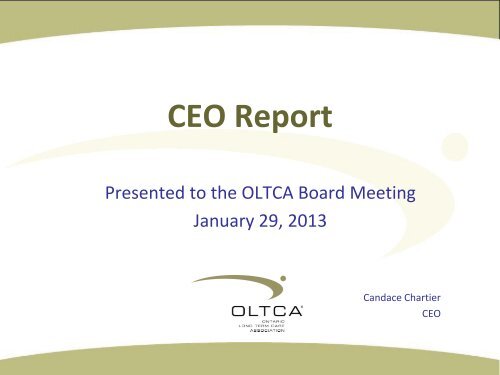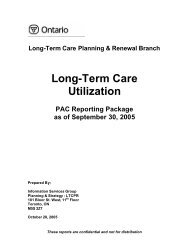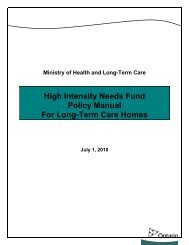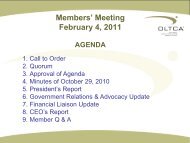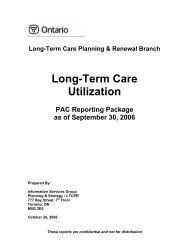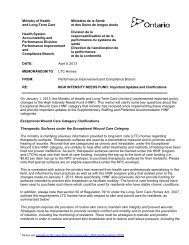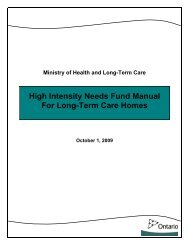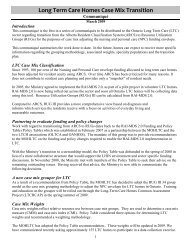CEO Report January 2013 - Ontario Long Term Care Association
CEO Report January 2013 - Ontario Long Term Care Association
CEO Report January 2013 - Ontario Long Term Care Association
You also want an ePaper? Increase the reach of your titles
YUMPU automatically turns print PDFs into web optimized ePapers that Google loves.
<strong>CEO</strong> <strong>Report</strong><br />
Presented to the OLTCA Board Meeting<br />
<strong>January</strong> 29, <strong>2013</strong><br />
Candace Chartier<br />
<strong>CEO</strong>
Environmental Scan<br />
<br />
<br />
<br />
<br />
<br />
<br />
<br />
Kathleen Wynne is the new leader of the <strong>Ontario</strong> Liberal Party and Premier of <strong>Ontario</strong>.<br />
Wynne was elected on the 3rd ballot – her victory sealed when Charles Sousa and Gerard<br />
Kennedy joined Eric Hoskins in support of Wynne’s candidacy<br />
Wynne has said she will call the Legislature back on February 19 and introduce a budget<br />
before the end of March (a Speech from the Throne would proceed the Budget)<br />
Early stated priorities include welfare reform and public-sector wage restraint<br />
Wynne has indicated support for current direction at MOHLTC<br />
Wynne has said that she wants to avoid an election - Horwath and Hudak have given her a<br />
list of demands to secure their cooperation<br />
» NDP wants a public inquiry into the cancellation of two gas plants before the last election.<br />
» Hudak wants government to get control of overspending, create jobs and respect the taxpayers<br />
Tories launched critical radio ads highlighting that Wynne was part of the government<br />
scandalized by ORNGE, eHealth, and gas-plant cancellations<br />
2
Environmental Scan<br />
MOHLTC released of highlights of Seniors Strategy on <strong>January</strong> 8, <strong>2013</strong><br />
<br />
<br />
OLTCA issued news release highlighting the adoption of a number of <strong>Association</strong><br />
recommendations, such as<br />
» The development of an evidence informed capacity planning process<br />
» Increasing short-stay respite and convalescent-care program capacity<br />
» Exploring the ability of LTC homes to serve as community-care hubs<br />
» Streamlining application and placement processes to improve flow to and from LTC<br />
homes<br />
» Providing additional training opportunities for staff and supporting them in releasing<br />
time to care<br />
Full report with 166 recommendations to be released in late <strong>January</strong>/early February<br />
<br />
Dr. Sinha expected to stay on for a year to oversee implementation<br />
Oltca examining recommendations – have invited Sinha to address Members on February 14.<br />
3
Contents<br />
Updates Provided According to our Three<br />
Strategic Priorities:<br />
Build OLTCA Capacity to Deliver on<br />
<strong>Association</strong> & Member Priorities<br />
Secure Capital Redevelopment and LTC<br />
Funding Reform<br />
Promote Quality <strong>Long</strong> <strong>Term</strong> <strong>Care</strong> Programs<br />
and Services<br />
4
Build OLTCA Capacity to Deliver on<br />
<strong>Association</strong> & Member Priorities<br />
<br />
<br />
<br />
<br />
<br />
<br />
Health System Funding Reform<br />
Change Committee<br />
» Quality in Community <strong>Care</strong> Reference Table<br />
Operators’ Stakeholder Liaison Committee<br />
All Agency Engagement Session Table<br />
System Strategy Council<br />
Funding Notifications<br />
5
Health System Funding Reform<br />
<br />
MOHLTC has published a three year outlook for HSFR however ministry<br />
realizes that there is a potential gap in the framing of the QBP paradigm<br />
across the continuum of care.<br />
<br />
MOHLTC is aligning QBP approach with broader health system<br />
transformation goals by taking a population-based approach focused on<br />
high users to tie funding directly to user cohorts with the highest service<br />
intensity needs and highest cost.<br />
<br />
High Users are CCAC (focus for CCAC will be quality based funding on the<br />
“complex” population) and LTC which includes the entire LTC population.<br />
Aim is to implement Acute care QBP and Quality carve outs by April 1, <strong>2013</strong><br />
and LTC/Community by April 1, 2014.<br />
6
Community<br />
While the Ministry has published a three-year outlook plan for HSFR, there is a potential gap in<br />
the framing of the QBP paradigm across the continuum of care<br />
Sector Year 1<br />
April 2012<br />
Hospital<br />
(% of PBF Base)<br />
Community <strong>Care</strong><br />
Access Centre<br />
(% of PBF Base)<br />
<strong>Long</strong>-<strong>Term</strong> <strong>Care</strong><br />
Homes (% of<br />
overall Ministry<br />
Funding)<br />
Year 2<br />
April <strong>2013</strong><br />
Year 3<br />
April 2014<br />
HBAM 40% 40% 40%<br />
Quality-Based<br />
Procedures<br />
6% 15% 30%<br />
HBAM 10% 30%<br />
Quality-Based<br />
Procedures<br />
HBAM (Case Mix) 60%<br />
Quality-Based<br />
Procedures<br />
1% TBD<br />
N/A<br />
70%<br />
65% 70%<br />
7
What is Known I: A population-based approach focused on high users is<br />
already an accepted foundation in the Community Sector (LTC and CCAC)<br />
<br />
<br />
<br />
<br />
A population approach can be used to tie funding directly to user cohorts with<br />
the highest service intensity needs and highest cost.<br />
Aligned with broader health system Transformation goals.<br />
Recognizes the complexity of care involved in these sectors (vs. episodic acute care).<br />
Supported by several key stakeholders (M. Mottershead – former <strong>CEO</strong> OACCAC, Camille<br />
Orridge, All Agency Forum).<br />
High Users:<br />
CCAC: Already use this Client <strong>Care</strong> Model to<br />
stratify clients based on service intensity needs.<br />
» Focus for CCAC quality-based funding<br />
will be on the “Complex” population.<br />
<br />
LTC: This cohort makes up the entire LTC<br />
population.<br />
OACCAC Client <strong>Care</strong> Model
The variations in patient care perpetuated by the historical funding approach,<br />
warrant the move towards a system where ‘money follows the patient’<br />
Hospitals, Community<br />
<strong>Care</strong> Access Centres and<br />
<strong>Long</strong> <strong>Term</strong> <strong>Care</strong> are the<br />
first sectors incorporated<br />
into the funding strategy<br />
Health System<br />
Funding Reform<br />
Patient-Based Funding is<br />
based on clinical clusters<br />
that reflect an individual’s<br />
disease, diagnosis,<br />
treatment and acuity<br />
Patient-Based<br />
Funding<br />
(70%)<br />
Global<br />
(30%)<br />
Patient-Based Funding<br />
will include HBAM and<br />
Quality-Based Procedures<br />
Health Based<br />
Allocation<br />
Method<br />
(40%)<br />
Quality-Based<br />
Procedures<br />
(30%)<br />
HBAM is a ‘made in <strong>Ontario</strong>’ funding model that provides<br />
organizational-level allocations informed by case-mix utilization<br />
and aggregate cost, volume and types of patients and providers<br />
Focus of new table for Community/LTC<br />
Quality Based Procedures (QBPs) are clusters of patients<br />
with clinically related diagnoses or treatments that have<br />
been identified by an evidence-based framework as<br />
providing opportunity for process improvements, clinical redesign,<br />
improved patient outcomes, enhanced patient<br />
experience and potential cost savings<br />
9
Overarching HSFR Governance Structure<br />
HSFR Initiative<br />
ADM Leads: D. Young; S. Fitzpatrick<br />
Executive<br />
Committee<br />
Steering<br />
Committee<br />
Change<br />
Management<br />
Committee<br />
Director Committee<br />
Academic<br />
Advisory<br />
Committee<br />
Organizational-Level PBF Working Groups<br />
(External/Internal)<br />
*<br />
*<br />
Acute<br />
Inpatient<br />
and ER<br />
Home <strong>Care</strong><br />
<strong>Long</strong> <strong>Term</strong><br />
<strong>Care</strong><br />
Homes<br />
Local<br />
Partnerships<br />
Applied Learning Program<br />
Small<br />
Hospitals<br />
*<br />
In-Patient<br />
Mental<br />
Health<br />
*<br />
Inpatient<br />
Rehab/CCC<br />
*<br />
Revenue<br />
Working<br />
Group<br />
* Various sub-groups have been formed to further focus on detailed HSF components<br />
10
As implementation evolves, a number of products and knowledge-to-action<br />
toolkits will be developed to help guide the work going forward<br />
Clinical<br />
• Quality-Based Procedures’ Definitions<br />
• Best Practices<br />
• Clinical Handbooks<br />
• Clinical Engagement<br />
Pricing/ Funding<br />
• Quality-Based Procedure Best Practice Price<br />
• Quality Overlay Framework<br />
Capacity Planning<br />
• Volume Management Strategy<br />
• Capacity Utilization and Forecasting Program<br />
Monitoring and Evaluation<br />
• Integrated Quality-Based Procedure Scorecard<br />
11
AGENCY PARTNERS (e.g. CCO)<br />
Clinical Expert Advisory Groups<br />
Regional-Level *Regional-Level<br />
Front-line Clinicians<br />
Proposed stakeholder engagement/ outreach model to strengthen sector buy-in<br />
Coronary<br />
Pulmonary<br />
Obstructive<br />
Disease<br />
Colonoscopy<br />
Medical<br />
Advisory<br />
Council<br />
Nursing<br />
Advisory<br />
Council<br />
Congestive<br />
Heart Failure<br />
Stroke<br />
Clinical Expert Advisory Groups<br />
Co-Chairs<br />
• Advise QBP clinical engagement<br />
implementation strategy<br />
• Identify clinical lead champions<br />
• Strengthen clinical focus through engaging<br />
physicians, nurses & other health disciplines<br />
LHIN Leads<br />
Forum<br />
e.g. Primary<br />
<strong>Care</strong>, Critical<br />
<strong>Care</strong>, ED etc.<br />
Chemotherapy –<br />
Systemic<br />
Treatment<br />
Non-Cardiac<br />
Vascular<br />
Access<br />
To <strong>Care</strong><br />
Advisory<br />
Council<br />
Provincial<br />
Programs<br />
Quality<br />
Collaborative<br />
Provincial-Level<br />
All<br />
Agency<br />
Forum<br />
Current<br />
Clinical<br />
<strong>Association</strong><br />
Networks<br />
* Examples of communication channels include webinars, face-to-face sessions, workshops etc.<br />
These sessions would be Ministry hosted in collaboration with the co-chairs of the Advisory Groups<br />
Centre for<br />
Effective Practice<br />
12
Change Committee<br />
<br />
Transformation Secretariat has launched a new initiative called “Health Links” that will facilitate<br />
collaboration between local health care providers to coordinate care for high need clients.<br />
<br />
Health Links will enable LHINs to work with all HSPs in a community to coordinate services and<br />
care delivery at the client level, and enhance care delivery and patient experience, while reducing<br />
costs.<br />
<br />
Health Links are accountable to the LHINs. It is a voluntary initiative - several early adopter<br />
communities have stepped forward to implement.<br />
Next steps will focus on the following:<br />
Sector Engagement: Alignment Discussions<br />
1. Local Partnerships (LPs) - act as an advisory group, facilitating clinical, financial and decision<br />
support and advice to and from the LHINs and MOHLTC<br />
2. Leadership Series<br />
3. QBPs: Plan for Engaging Clinical Leaders<br />
13
Change Committee<br />
HSPs including LTCHs will have a role:<br />
1. In co-chair the LP and proactively engage through the LP with a systems and organizational<br />
perspective to inform local change and provincial HSFR approaches<br />
2. Transfer knowledge back to host organization and surrounding provider partners<br />
3. Ensuring key staff participate in training and education<br />
4. Ensuring full organizational participation in local change management activities.<br />
‣ Sector engagement sessions will be held to engage LHINs and HSPs through education and discussion of<br />
the strategic and operational management of health system funding reform<br />
‣ There will be three phases of education (self study modules which will be a pre-requisite for next phases, inperson<br />
sessions focus on details of HSFR and webinars focusing on HBAM methodology). The initial<br />
audience will be LHINs, Hospitals and CCACs.<br />
14
Change Committee<br />
Quality in Community <strong>Care</strong> Reference Table<br />
<br />
New table formed to implement HSFR across Community and LTC<br />
<br />
Co-Chairs are Camille Orridge (<strong>CEO</strong>-TC LHIN) and Dan Burns (<strong>CEO</strong>-OACCAC)<br />
<br />
Initial meeting held <strong>January</strong> 14 th and <strong>Term</strong>s of Reference and work plan were<br />
outlined<br />
Next steps:<br />
<br />
Reviewing the Acute QBP Evaluation Framework – will it work for Community/LTC<br />
<br />
Focusing on the “Functional Based QBPs”<br />
<br />
Timeline: Implementation April 1, 2014…A LOT OF WORK TO BE DONE!!<br />
15
What is Known II: The evidence-based framework for selecting current QBPs…<br />
Does this population contribute to a significant<br />
proportion of total costs<br />
Is there potential for cost savings or efficiency<br />
improvement<br />
Is there potential areas for integration<br />
Will this contribute directly to Transformation goals<br />
and objectives<br />
Cost / Impact on<br />
Transformation<br />
Client<br />
or<br />
Residen<br />
t<br />
Groups<br />
Using the Acute QBP Evaluation<br />
Framework as a foundation, this<br />
is what it could look like in the<br />
Community.<br />
Is there data and reporting infrastructure in place<br />
Are there clinical leaders able to champion this<br />
Can we leverage other initiatives or reforms<br />
Feasibility<br />
Availability<br />
of Evidence<br />
Known Quality<br />
Issues<br />
Is there a clinical evidence base for<br />
best practices<br />
Is costing and utilization information<br />
available<br />
Quality-Based<br />
Procedures or<br />
Populations<br />
Is there a known quality issue or<br />
variation in outcomes<br />
Is there a high degree of practice variation<br />
Health Quality Branch 16<br />
16
Building on the Current State: Proposed approach to reframe the paradigm of QBPs across<br />
the continuum of care<br />
Population-<br />
Based<br />
Diagnosis-<br />
Based<br />
Cataracts *<br />
Hip Replacement *<br />
Knee Replacement *<br />
Phase 2 Ortho ** †<br />
Stroke **<br />
Chemo (systemic treatment)**<br />
Colonoscopy**<br />
Coronary Artery Disease**<br />
CHF**<br />
CKD*<br />
COPD**<br />
Gastrointestinal Surgery ***<br />
Thoracic Surgery ***<br />
Spinal ***<br />
Gastric Bypass ***<br />
Phase 3 Ortho ***<br />
Complex Chronic<br />
Disease Model<br />
Outpatient > Inpatient<br />
Proportion of <strong>Care</strong> provided in the Community<br />
Short-<strong>Term</strong> Cross-<br />
Sectoral Episode<br />
Inpatient > Outpatient<br />
TBD<br />
TBD<br />
TBD<br />
TBD<br />
TBD<br />
Acute Episodic<br />
Inpatient only<br />
These features are often<br />
presented in populations such as<br />
high-risk frail seniors and highneeds<br />
mental health and<br />
addictions<br />
Functional-<br />
Based<br />
•Implemented in Year 1<br />
** For implementation in Year 2<br />
*** Proposed for implementation in Year 3<br />
† CCAC to Provider level Outcome-Based Reimbursement for Year 2<br />
>2 co-morbidities ***<br />
Wounds / ulcers *** †<br />
Palliative ***<br />
Risk of falls ***<br />
Behaviours / dementia ***<br />
Frail elderly ***<br />
Health Quality Branch<br />
17
High Level Timelines<br />
Jan 13<br />
Policy options analysed,<br />
recommend approach<br />
selected<br />
Nov 12<br />
Governence<br />
established<br />
Jan <strong>2013</strong> - Jun <strong>2013</strong><br />
Expert advisory consultations<br />
to validate approach, define<br />
cohorts, select indicators.<br />
Jul <strong>2013</strong> - Aug <strong>2013</strong><br />
Impact modelling<br />
Sep <strong>2013</strong> - Jan 2014<br />
Sector engagement<br />
Apr 2014<br />
Additional Community<br />
funding changes<br />
(MOH to CCAC/LTC)<br />
Jan 2014 - Mar 2014<br />
Develop funding pkgs &<br />
sector support products<br />
Jan <strong>2013</strong> Apr <strong>2013</strong> Jul <strong>2013</strong> Oct <strong>2013</strong> Jan 2014<br />
October 2012<br />
Jan 13<br />
Quality in the Community Reference<br />
April 2014<br />
Table Kick-Off Meeting<br />
Apr <strong>2013</strong><br />
Wound, Hips, Knees<br />
Outcome-Based Reimbursement (OBR)<br />
Implementation CCAC to Provider<br />
(approx 5% of CCAC purchased services budget)<br />
Apr 2014<br />
Additional CCAC to Provider<br />
level Outcome-Based<br />
Reimbursement (OBRs)<br />
18
Operators’ Stakeholder Liaison Committee<br />
Updates provided on several areas including:<br />
<br />
Fire Safety/Sprinklers: Both associations thanked for feedback, some monies will be forth<br />
coming and some earmarked for <strong>2013</strong>/14. A proposal has been drafted and is making its way<br />
through the system. There will be greater flexibility to use funds.<br />
<br />
Physician On Call Funding: Funding changes retroactive to April 2011. Proposed change would<br />
give $12.5K to homes with less than 30 beds, $15K to homes with 30-149 beds and homes with<br />
150 beds and over would get $100/bed.<br />
<br />
Funding flexibilities: Found through the webinars and Q&A process that some small homes<br />
weren’t budgeting annually, recognize there may be pressures and will monitor, variable cost<br />
issues for products, looking at local solutions for areas like transportation costs, etc.<br />
<br />
Regulatory changes: Regulatory changes are moving through approvals - increasing<br />
convalescent care beds, shift from choice-base to referral-base, clarifying CIS reporting,<br />
specialized units, more flexible HHR.<br />
19
All Agency Engagement Session Table<br />
“The pursuit of quality and evidence is a driving force for HSFR and should always be at<br />
the forefront of healthcare decisions”<br />
<br />
Work is underway to define community-focused QBPs. It is critical that socializing of stakeholders<br />
begins on the proposed approach to reframe the paradigm of QBPs across the continuum of care.<br />
<br />
As QBPs are reframed across the continuum of care, it will become increasingly important to link<br />
QBP activity to primary care.<br />
<br />
As implementation evolves, the Clinical Expert Advisory Groups will need to be expanded to<br />
include representation from other sectors (i.e. community, LTC, primary care etc.) and patient<br />
advocates.<br />
<br />
LHINs need to be a part of the QBP planning and decision-making process, specifically around<br />
service capacity planning.<br />
20
System Strategy Council Table<br />
<br />
Table consists of: OHA, OLTCA, OAHNSS, OHCA, ALPHA, AOHC, OACCAC, CAMH, LHINs,<br />
LINK, etc.<br />
<br />
Meetings dedicated to roundtable discussion on advancing the quality agenda in <strong>Ontario</strong>.<br />
<br />
Focusing on Quality Outcomes and asking every association to share their sector priorities as well<br />
as insights into opportunities, challenges and tactics for accelerating quality improvement efforts.<br />
<br />
LHINs provided an update on 3 current areas of focus and invited feedback from the Council;<br />
advancing <strong>Ontario</strong>’s transformation agenda, partnership for palliative care and aligning primary<br />
care<br />
<br />
Overall key messages:<br />
‣ general agreement that preliminary priorities of Transformation Secretariat were appropriate<br />
‣ significant alignment in quality focus across sectors but some at different stages<br />
‣ areas of opportunity for collaboration and alignment and creating shared accountability for clients<br />
‣ LHINs will play important role in facilitating alignment of quality priorities<br />
‣ HSFR will be the enabler for transformation<br />
21
Secure Capital Redevelopment<br />
and LTC Funding Reform<br />
Capital Redevelopment Update<br />
Capital Redevelopment Table<br />
22
Capital Redevelopment Update<br />
<br />
Refocusing our Capital Redevelopment package from meetings held in the fall<br />
(OLTCA Roundtable, Deputy Minister meeting, Don Young meeting).<br />
<br />
Contacting Brenda Blackstock (IO update) and Catherine Brown (senior table) to reestablish<br />
the senior table that was set up before the holidays.<br />
<br />
Additional analysis as outcome from FLC meeting to strengthen our conversations.<br />
<br />
Opportunity through different tables we are at to position capital redevelopment.<br />
<br />
Recommendations from Dr. Sinha’s report sets foundation for discussions:<br />
“76. The Ministry of Health and <strong>Long</strong>-<strong>Term</strong> <strong>Care</strong> should improve the quality of longterm-care<br />
accommodation by improving the conditions for redevelopment of the<br />
approximately 35,000 remaining B, C and upgraded D beds.“<br />
23
The Future of LTC<br />
“No one disagrees that we eventually will have to build more LTC homes in<br />
<strong>Ontario</strong>. However, many agree that there also exists significant potential to<br />
divert demand for long-term care to other care settings, settings that would<br />
likely be more cost effective and more aligned with patient preference…While<br />
providing long-term care for those with complex needs and limited options to<br />
remain at home in the community will always remain the predominant focus of<br />
this sector, increasing the capability of the sector to provide a variety of shortstay<br />
care services could better support the transitional care needs and<br />
preferences of older patients …This transition also needs to encompass the<br />
provision of enhanced palliative care services and the development of the<br />
necessary expertise to deliver it, in long-term care homes, to enable more<br />
residents to die in these homes rather than in a hospital setting.”<br />
- Dr Samir Sinha, p. 116-117<br />
24
Capital Redevelopment Table<br />
Senior table requested to deal specifically with a viable Capital Renewal Program.<br />
Table cannot exceed 15 people and would include:<br />
<br />
<br />
<br />
<br />
<br />
<br />
2 each from OLTCA/OAHNSS<br />
2-3 from LHIN<br />
Rachel Kampus/Catherine Brown<br />
Peter Kaftarian/Don Young<br />
Brenda Blackstock<br />
Technical person for design (MOHLTC)<br />
<br />
Other (potentially financing and maybe on an ad-hoc basis), if this is the case we<br />
would negotiate to have an OLTCA expert float in on an ad-hoc basis for the various<br />
modules (design, financing, funding, etc.)<br />
25
Promote Quality <strong>Long</strong> <strong>Term</strong> <strong>Care</strong><br />
Programs and Services<br />
LTC Roadmap Executive Advisory<br />
MOHLTC/PSHSA Indicator Project<br />
Worker Consultation Task Group<br />
26
LTC Roadmap Executive Advisory<br />
Reviewed the 3 key priorities for the committee; Access, Quality and Integration<br />
Access<br />
<br />
Goal: Maximize the utilization of diversity of LTC long and short stay programs (right<br />
care, right place, right time)<br />
Quality<br />
<br />
Goal: Strengthen sector capacity, human resources, innovation and quality<br />
Integration<br />
<br />
Goal: Support LHIN-based system capacity planning to match programs and<br />
population needs along the continuum<br />
Goals and Outcomes reviewed and roundtable input for final editing, action items will be<br />
reviewed next meeting.<br />
Next steps: <strong>Association</strong>s to set up meeting to determine enablers and levers to build<br />
capacity and opportunities to come back to the table with how we can align with<br />
community supports, integration opportunities and sector capicity (OLTCA, OAHNSS,<br />
OARC and OLTCP).<br />
27
MOHLTC/PSHSA Indicator Project<br />
<br />
A new project, that will be seeking input and advice about potential healthy<br />
and safe workplace indicators through an online survey.<br />
<br />
The Public Services Health and Safety <strong>Association</strong> is leading the initiative<br />
funded by the Ministry of Health and <strong>Long</strong>-<strong>Term</strong> <strong>Care</strong> (Health Force<br />
<strong>Ontario</strong>)<br />
<br />
Goal is to recommend a set of core, consensus-based healthy and safe<br />
workplace indicators for <strong>Ontario</strong>’s healthcare<br />
http://www.healthyworkenvironments.ca/Resources_Indicator_Project.htm.<br />
<br />
The project timelines are tight, responses required mid-<strong>January</strong> to early<br />
February, <strong>2013</strong>. On The Radar asked you to share the survey with your<br />
members. First meeting of group to be held March 1 st .<br />
28
Worker Consultation Task Group<br />
<br />
The Ministry of Labour has initiated the new Vulnerable Worker<br />
Consultation Task Group.<br />
<br />
Task force selected by Ministry with diverse group across all sectors<br />
(posted on ministry website)<br />
<br />
Aim is to provide critical stakeholder perspectives and advice to the ministry<br />
on the prevention of workplace injuries and occupational diseases affecting<br />
vulnerable workers in the Province of <strong>Ontario</strong>.<br />
Initial launch and consultation meeting February 27 th <strong>2013</strong>.<br />
29
Other Updates –<br />
Changes in the Ministry<br />
<br />
Wiesia Kubica who has many files such as fire prevention, rate reduction, envelope<br />
eligibility, direct funding agreements, task force agreement and some regulatory<br />
matters has now moved to the Deputy Ministers office from the PIC Branch.<br />
<br />
Margaret Allore who we were getting closer to and was Catherine Brown’s right hand<br />
has moved to fill Wiesia’s position in PIC Branch.<br />
<br />
Theresa Nowak will now be overseeing rate reduction but not sure about all the other<br />
files…<br />
30
Other Updates –<br />
Changes in the OLTCA Staffing<br />
<br />
Len Koroneos acting as interim for Director Financial Policy and Planning, transition<br />
plan completed for file status and update.<br />
<br />
Four Corners have been acquired and have completed positing and candidate profile,<br />
currently posted on <strong>Long</strong>woods, Linkedin and CCHL-CCLS.<br />
<br />
Lesley Atkinson has decided to step down from the Director Communications and<br />
Public Relations and continue to stay on to assist with Task Force on Resident<br />
Safety, candidate interviewed for position by Brian Pollard, Lesley and Pat McCarthy.<br />
<br />
Job posting closed Jan 11 th for Senior Communications Advisor and interviews being<br />
held <strong>January</strong> 31 st and February 1 st .<br />
<br />
Draft job description for Senior Policy Advisor to be approved by Board and job<br />
posting will go out immediately thereafter.<br />
31
Other Updates –<br />
Changes in the OLTCA Staffing<br />
<br />
Complete analysis completed of all job descriptions in office, all positions reviewed<br />
with staffs and sign off received as well as all Performance Appraisals completed (all<br />
job descriptions now current as of <strong>January</strong> <strong>2013</strong> and will be reviewed annually<br />
thereafter).<br />
<br />
Brian Baillie job description revised with enhanced responsibilities to ensure office<br />
operations and management consistent and administrative communication plan<br />
adhered to.<br />
<br />
Senior staff and all staffs team communications scheduled on a weekly basis.<br />
<br />
Once all staffs in place an assessment will be conducted by Senior Staff to assess if<br />
any gaps – goal is to have full staff complement in order to support Strategic Plan<br />
and Business Plan by May and then Staff Retreat to solidify relationships and share<br />
all job descriptions in order to facilitate an effective and efficient office environment.<br />
32
Other Updates –<br />
Website Update<br />
<br />
<br />
<br />
<br />
<br />
<br />
Complete analysis to be completed of status of website by….<br />
Website Action Plan developed and all staff inserted responsibilities and updates to<br />
get a picture of what is required and what has been completed to date.<br />
Updates to be incorporated and discussed at Senior Staff and team communications<br />
scheduled on a weekly basis.<br />
Once new analysis completed we will review timeline and cost and feasibility of<br />
website being completed by March 31 st . A phased in approach is being planned.<br />
Online Directory completed.<br />
Assessment will include 2 - 4 days review the material from each staff outlined in<br />
action plan as well as, reviewing the Drupal website, reviewing the CiviCRM<br />
implementation, meeting with people to understand what remains to be done and<br />
what the priorities are, and writing a phased action plan with estimates to be delivered<br />
about the end of next week...<br />
33
Looking to the Future -<br />
Opportunities and Challenges<br />
<br />
It is going to be a very fast paced environment and it will be essential for<br />
members to establish key new relationships in the community (Health Links).<br />
<br />
We have to be proactive and put solutions forward of the “possibilities” during<br />
this “redefining LTC” shift…balance our asks with what we feel we can deliver.<br />
<br />
More effectively utilize the relationships between our member homes and<br />
commercial members and highlight the innovative quality landscape that we<br />
foster.<br />
<br />
Communication across membership and with stakeholders is crucial - we need<br />
to establish a plan/process so that we have an ear to the ground and can keep<br />
ahead of the curve…<br />
34


